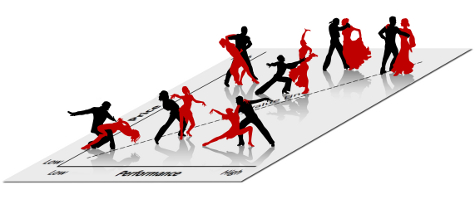Choreographing the competitive dance
Planning moves in a competitive environment (Janvier 10, 2013)
Several months ago, I found myself in a dance hall in the middle of Moscow. It was Tango Night! I could see that it was a very structured, disciplined dance. With limited tango skills, I was able to watch and enjoy the wonder of a dance floor moving in front of me, everyone reacting to everyone else as the music played.
To choreograph the competitive dance that happens in every selling situation, you first need to understand why people are out on the dance floor in the first place. That sits squarely in understanding what the customer values. Specifically, understanding the issues or problems that have direct impact on the customer’s business performance; where they feel the fire to take action; their most compelling business issue. You also need to understand clearly what the customer values with respect to a solution. Once you have this compelling business issue demanding action and the customer’s characteristics of an ideal solution,
 you can now draw the borders of the dance floor. Price (Y axis) includes things like acquisition costs, life cycle, switching costs or maybe some other industry-specific factors. Performance (X axis) includes ease of purchase and acquisition, product features and delivery, business impact or even personal impact. The more descriptive you are here around the customer’s understanding of an ideal solution and your (and your competitors’) alignment with those descriptors, the better you are able to choreograph the moves.
you can now draw the borders of the dance floor. Price (Y axis) includes things like acquisition costs, life cycle, switching costs or maybe some other industry-specific factors. Performance (X axis) includes ease of purchase and acquisition, product features and delivery, business impact or even personal impact. The more descriptive you are here around the customer’s understanding of an ideal solution and your (and your competitors’) alignment with those descriptors, the better you are able to choreograph the moves.
Take a moment to plot your customer, yourself and your competitors on this newly defined dance floor with the Price and Performance axes setting the boundaries. Where are you, compared to how the customer defines value? Where are the other competitors? It’s important that you plot these positions based not on what you think about your Price and Performance, but on what you believe the customer thinks about it.
Step back and look at the dance floor. Where is everyone? Now, consider your strategy to outmanoeuvre the competition.
- Can you Pursue? If so, go head-to-head on price, features, delivery etc.
- Can and should you Reconfigure your offering? If so, change your offering to better align with the customer.
- Can and should you Re-frame? Help the customer see the situation differently—but only if it serves their interests and yours.
- If none of these three are right, even in combination, consider having a go/no-go discussion with your sales manager.
No matter what strategy you choose from the three above, remember that everyone moves. If you Pursue, Reconfigure or Re-frame, consider how the customer will react and how your competitors will react. You are choreographing a dance, so you cannot just consider one move. You have to anticipate and think ahead several moves. Executing this with discipline—the discipline of a dance like the tango—should give you a new framework to use as you focus on meeting your customers’ needs, priorities and interests better than the competition!








 Se il vous plaît remplir ce formulaire pour vous inscrire pour recevoir des articles et des documents.
Se il vous plaît remplir ce formulaire pour vous inscrire pour recevoir des articles et des documents.





